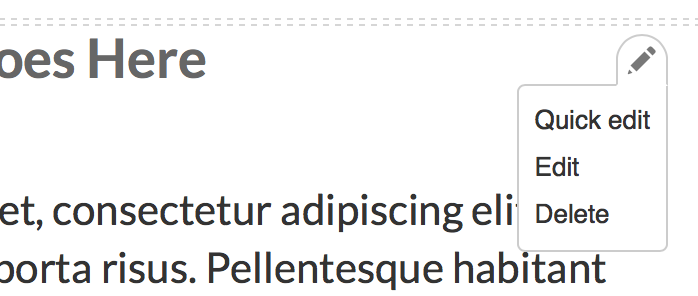...aka, avoid the annoying Javascript error below:
drupal.js:67
TypeError: undefined is not an object (evaluating 'entityElement
.get(0)
.getAttribute')Many themers working on Drupal 8 sites have Contextual menus and Quick Edit enabled (they're present in the Standard Drupal install profile, as well as popular profiles like Acquia's Lightning), and at some point during theme development, they notice that there are random and unhelpful fatal javascript errors—but they only appear for logged in administrators.
Eventually, they may realize that disabling the Contextual links module fixes the issue, so they do so and move along. Unfortunately, this means that content admins (who tend to love things like contextual links—at least when they work) and up not being able to hover over content to edit it.
There are two ways you can make things better without entirely disabling these handy modules:
- Apply the patch from this Drupal.org issue: contextual.js and quickedit.js should fail gracefully, with useful error messages, when Twig templates forget to print attributes.
- Make sure you always include
attributessomewhere in the wrapping class in all node templates, as well as{{ title_prefix }}and{{ title_suffix }}. If you don't, the contextual links module won't be able to inject the proper classes it needs to add the contextual link. And until the above patch hits Drupal core, any page where your template is used and a user with permission to use Contextual links visits, Javascript on that page will break!
As one quick example, I was working on a node template for a bootstrap theme, and it looked something like:
<div class="col-md-6">
<h2 class="lead">{{ label }}</h2>
<p class="small">{{ node.getCreatedTime() | date("F d, Y") }}</p>
<div class="body">
{{ content.body }}
</div>
{{ content|without('body') }}
</div>To fix this so the contextual link displays to the right of the title, I modified the template as in number 2 above, to look like:
<div{{ attributes }}>
<div class="col-md-6">
{{ title_prefix }}
<h2 class="lead">{{ label }}</h2>
{{ title_suffix }}
<p class="small">{{ node.getCreatedTime() | date("F d, Y") }}</p>
<div class="body">
{{ content.body }}
</div>
{{ content|without('body') }}
</div>
</div>Now, I get the handy little contextual link widget, and I can happily go about editing nodes within the context of the page I'm on (instead of digging through the admin content listings for the node!):

Note also the {{ content|without('body') }}—it's always important to render the entire {{ content }} element somewhere (even without() all the other fields on the node) so that cache tags bubble correctly—see a related core issue I opened a week or so ago: Bubbling cache tag metadata when rendering nodes in preprocess functions is difficult.
Comments
Thanks! We fixed the issue for most of our templates but I think we're still getting them for the system-branding-block and menu-blocks. Any ideas? I see that block.html.twig has title_prefix already and we're inheriting that template.
Hi Jeff. Thanks for sharing! It's basically the same in D7... you have to print the attribute and include the title suffix (not sure if you need the title prefix or not, but still, what a weird place to put contextual stuff, right?!!?)
Hi Jeff,
Good info.
Not sure if its missing to simplify the example, but for those reading this if you are rendering fields directly/specifically, its always a good idea to make sure to top level variable is also rendered at some point, otherwise you might have issues with cache tags bubbling up the page.
E.g.
content|without('body')
See https://www.previousnext.com.au/blog/ensuring-drupal-8-block-cache-tags… for more details
Most definitely! I didn't mention that, but I also would be remiss to not mention a related core issue where I'm hoping to make sure cache tag bubbling documentation and/or Theming Experience is improved for common use cases (like preprocessing nodes): Bubbling cache tag metadata when rendering nodes in preprocess functions is difficult.
I just wish there was a cleaner way to do this in some cases. Tying the contextual links to elements that you want to blow away attributes on, like in a cleaner atomic design paradigm, seems to be at odds with making content editor life easier.
I can't think of a reasonable alternative though...